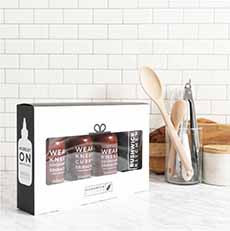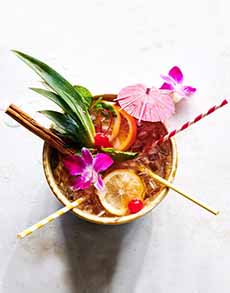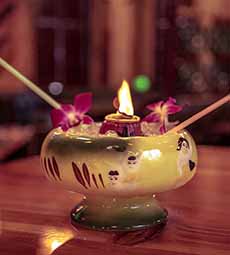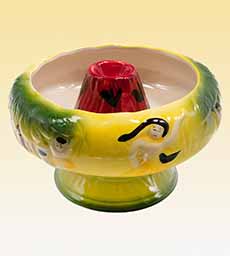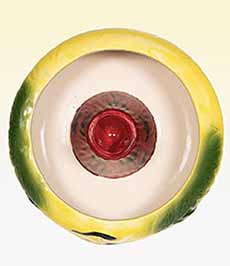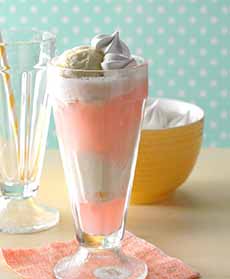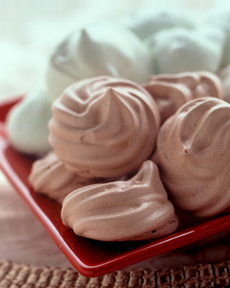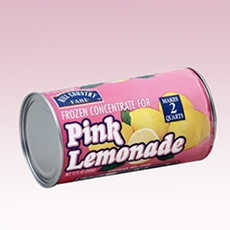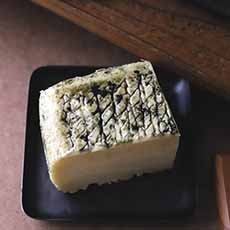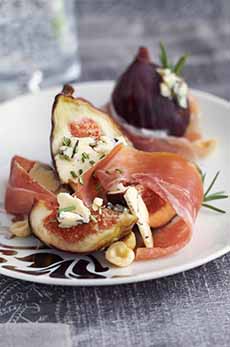|
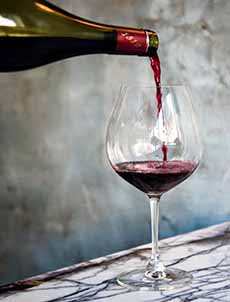
[1] Getting ready to enjoy a glass of Pinot Noir (photo © Rebelle | NYC [permanently closed]).
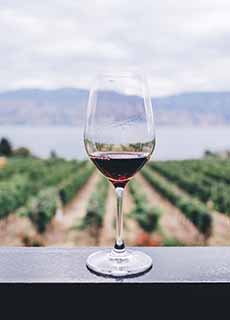
[2] Consider a wine vacation and the pleasure of tasting wine at the vineyard (photo © Kym Ellis | Unsplash).
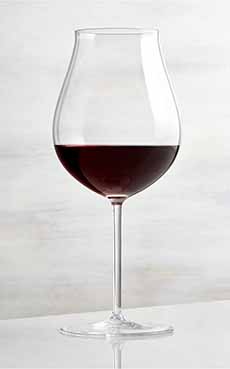
[3] A glass especially shaped for Pinot Noir. The funnel-shaped bowl allows pinot noirs to breathe and the slightly flared rim properly funnels their unique aromas. These are from Crate & Barrel (photos #3 and #4 © Crate & Barrel).
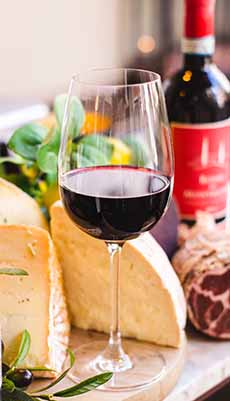
[4] Lighter red wines like Pinot Noir pair nicely with delicately flavored, washed-rind cheeses like Taleggio, and nutty, medium-firm cheeses like Gruyère (photo © Louis Hansel | Unsplash).
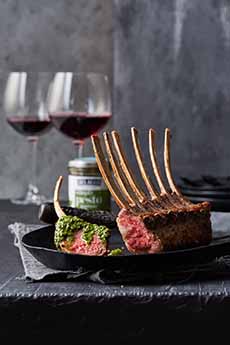
[5] A glass of Pinot Noir is delicious with lamb (photo © DeLallo).
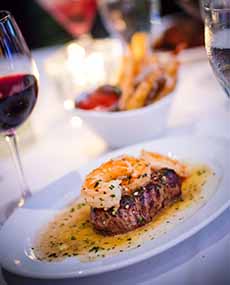
[6] Pinot Noir with Surf & Turf (photo © Ocean Prime).
|
|
Most wine drinkers have their favorite varietals; one of ours is Pinot Noir (PEE-no-NWAR), the great red grape from the Burgundy region of France. We celebrate it on August 18th, National Pinot Noir Day.
The name derives from the French words for pine (pin) and black (noir), inspired by the tightly clustered, pinecone–shaped bunches of Pinot Noir grapes, and their purple-black color.
Pinot Noir grapes are grown around the world, mostly in cooler climates. In France it’s known as Red Burgundy; elsewhere, the wine is named for the grape.
Beyond red wine, Pinot Noir grapes are also used in regular and Blanc de Noir Champagne, in sparkling white wines such as the Italian Franciacorta, and in English sparkling wines.
Why is a red wine grape used in white wines?
The flesh of most wine grapes is white (the exception is teinturier grapes*, whose flesh and juice are both red in color.
It’s only the skins that have different colors. So the juice pressed out of red grapes is the same color as juice pressed from white grapes. The difference is skin contact.
To make red and rosé wines, the pressed juice rests in a vat with the pressed skins, allowing the anthocyanins—antioxidant pigments present in the skins—to transfer their color to the juice.
THE WORLD’S TOP PINOT NOIR-GROWING REGIONS
Pinot Noir is one of the six “noble grapes” (cépages nobles) that have long been considered to have the potential to produce great wines: Cabernet Sauvignon, Chardonnay, Merlot, Pinot Noir, Riesling, and Sauvignon Blanc.
Beyond Burgundy, France, Pinot Noir has been transplanted and thrived in:
Oregon: the Willamette Valley.
California: the Carneros, Central Coast, Sonoma Coast, and Russian River AVAs†.
South Africa: the Elgin and Walker Bay wine regions of the Mornington Peninsula.
The Adelaide Hills, Great Southern, Tasmania, and Yarra Valley in Australia.
New Zealand: the Central Otago, Martinborough, and Marlborough wine regions.
There are also smaller regions making fine Pinot Noir wines, including Argentina, Australia, Austria, Canada, Chile, Germany, Italy, the Long Island AVA† in New York State, Moldova, the U.K., Slovenia, Spain, and Switzerland [source].
In the Champagne region of France, Pinot Noir is the most planted varietal (the others are Chardonnay and Pinot Meunier.
All of the areas where Pinot Noir grapes are grown have cool and humid climates, the perfect conditions for growing the superior Pinot Noir grapes.
The grape also does its best in well-drained, stony, or chalky soils.
As with any varietal, the wines will have different attributes based on both their terroir‡‡ and the stylistic preferences of the winemaker.
THE WORLD’S TOP MOST FINICKY GRAPE?
Pinot Noir is a difficult grape to grow, susceptible to rot because of those tightly-packed grape clusters. Beyond rot, the thin skins of the varietal make it susceptible to other infections and diseases. And the varietal has low yields.
After a successful harvest in the vineyard, there’s a further challenge in the winery.
The low levels of phenolic compounds in the grape produce mostly lightly-colored, medium-bodied and low-tannin wines that can often go through phases of uneven and unpredictable aging [source].
So why do winemakers grow this difficult grape? Because when the factors work, the wines are splendid.
When young, the wines tend to have red fruit aromas of cherries, raspberries, and strawberries.
As the wine ages, it can develop more vegetal and “barnyard” aromas that make the wine more complex and a unique delight.
WHERE TO START WITH PINOT NOIR
If you’re not an experienced Pinot Noir taster, it’s easy to start. Pinot Noir is approachable when young: dry with delicious fruit flavors (typically cherry and raspberry), and soft tannins.
It pairs with just about anything you’d want to eat with red wine, from classic pairings—charcuterie, cheeses**, chicken, duck, lamb, rabbit and other game, salmon and other fatty fish including tuna, mushrooms, pasta, pork, turkey, stews, veal—even beef, burgers, and pizza.
You can also raise a glass of Pinot Noir with non-spicy Asian cuisine. Red wine drinkers can enjoy it with sushi and sashimi dishes.
You can even enjoy it with dark chocolate!
Ask your wine store clerk for recommendations, and consider a gathering where a group can taste several different regions, or several wines from the same region, to compare.
THE HISTORY OF PINOT NOIR
The Pinot Noir grape may be only one or two generations removed from Vitis sylvestris, the original European wild grape.
Records date to before the first century C.E., when the Romans, invading the part of Gaul that is now the Burgundy region of France, noticed the Gallic tribes drinking wine made from a native, wild grape that we now call Pinot Noir.
The Romans delighted in the wine and cultivated the grape for more than 300 years during their occupation of the territory.
The vineyards subsequently came under the control of the nobility, and then the Benedictine monks of the Catholic Church. Because they believed that Pinot Noir grapes produced the best wine, Pinot Noir became the official wine used in the sacrament of Communion. That greatly expanded the wine’s visibility and popularity.
The Burgundy region was divided into church-owned vineyards and remained under the control of the monks until the French Revolution in 1789, when the vineyards were seized and distributed to local families.
But before that came a breakthrough in viticulture: The Benedictine monks, specifically the Cistercians who had branched off, were the first to realize that grapes grown in different areas produced different wines.
They came to the conclusion that not all vineyards were created equal, and that different grape varietals did better in different regions. This tenet that helped to create superior wines from then onward [source]. This subsequently led to the concept of terroir‡‡.
|

[7] A comparison of the different red wine varietals (chart © The Nibble).
________________
*The flesh is red due to anthocyanin pigments accumulating not just in the skin, but within the pulp of the grape berry itself. Here’s more about it and a list of wines made with teinturier grapes.
**Goat cheese, smoked cheese, semi-hard cheeses like Cheddar or Gouda, nutty cheeses like Gruyère, lighter blue cheeses, lighter washed rind cheeses like Taleggio, and sheep’s milk cheeses are all delicious with Pinot Noir.
†An American Viticultural Area, or AVA, is a type of appellation of origin used on wine labels. An AVA is a delimited grape-growing region with specific geographic or climatic features that distinguish it from the surrounding regions and affect how grapes are grown. Here’s more about it.
‡Currently, some writers are questioning this classification. Five of the noble grapes are French, and one, Riesling, is German, though it’s also grown in Alsace. The phrase “cépages nobles”) originated in France, and that hierarchies like the can be limited in perspective. Plus, the classification was created before these grapes were planted all over the world. The quality of the grapes grown elsewhere is often not the same as the quality of the same grapes grown in France’s best vineyards. Here’s more about it.
‡‡Terroir, pronounced tur-WAH, is a French agricultural term referring to the unique set of environmental factors in a specific habitat that affects a crop’s qualities. These include climate, elevation, proximity to a body of water, slant of the land, soil type, and amount of sun. These environmental characteristics give the wines produced from these grapes a unique character.
CHECK OUT WHAT’S HAPPENING ON OUR HOME PAGE, THENIBBLE.COM.
|








